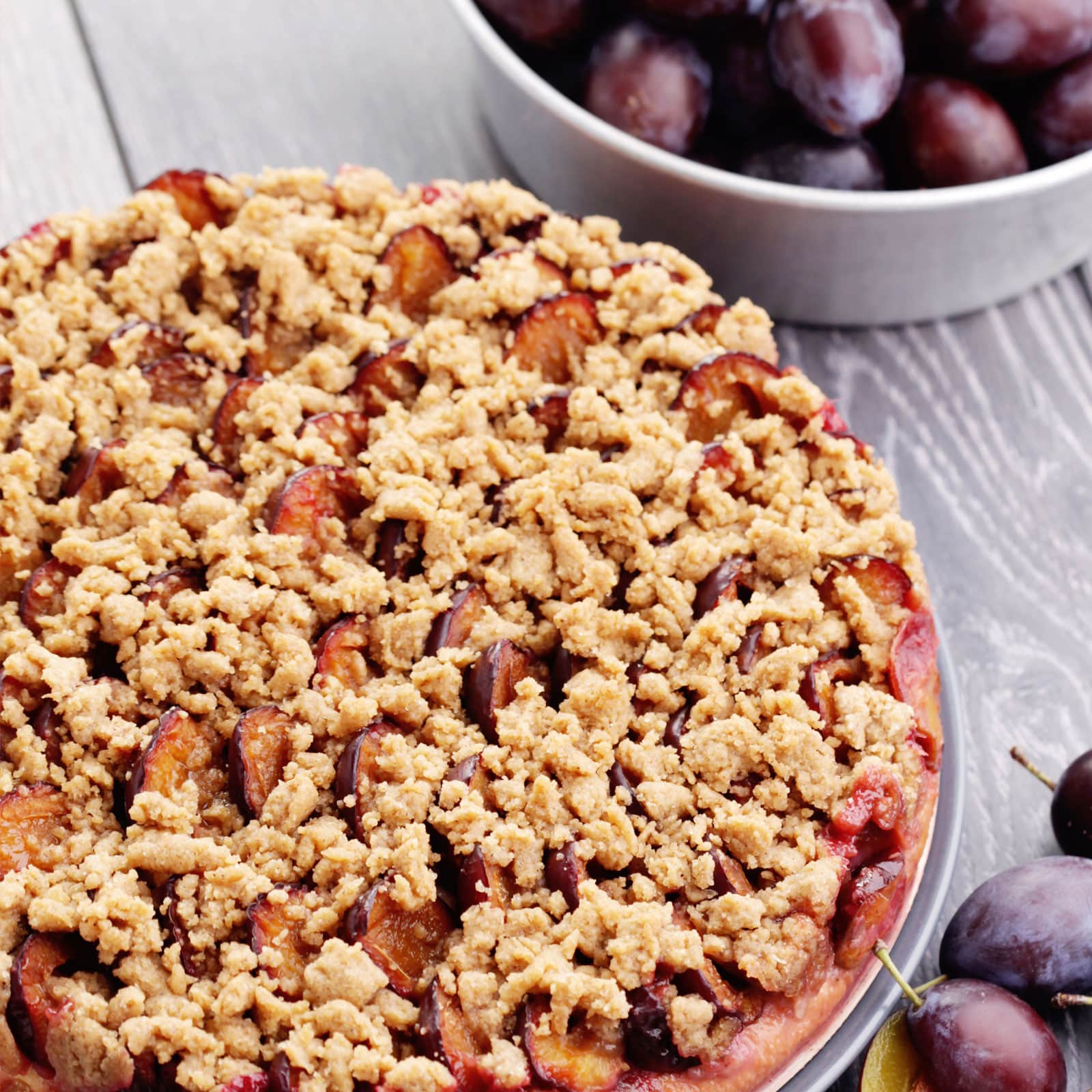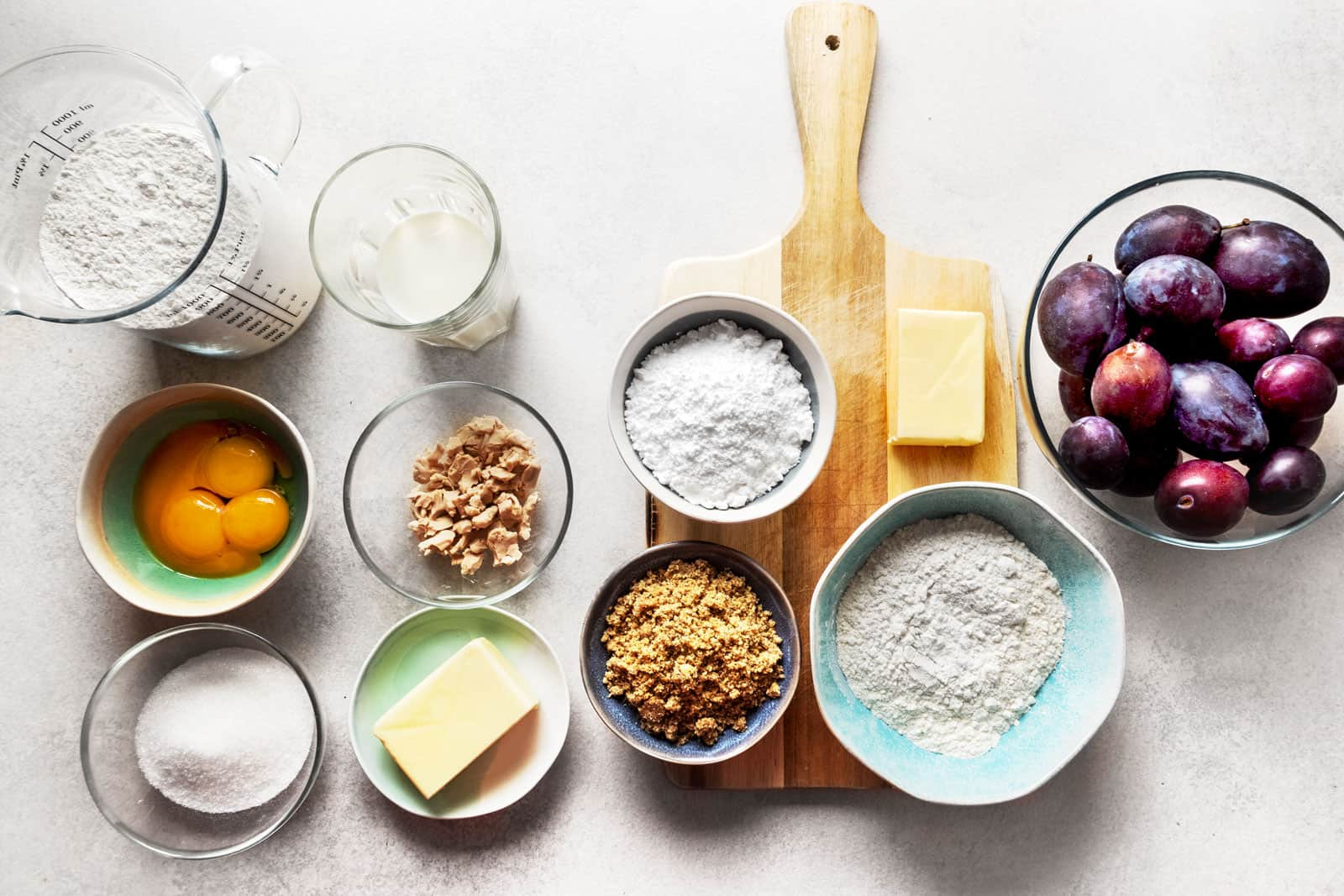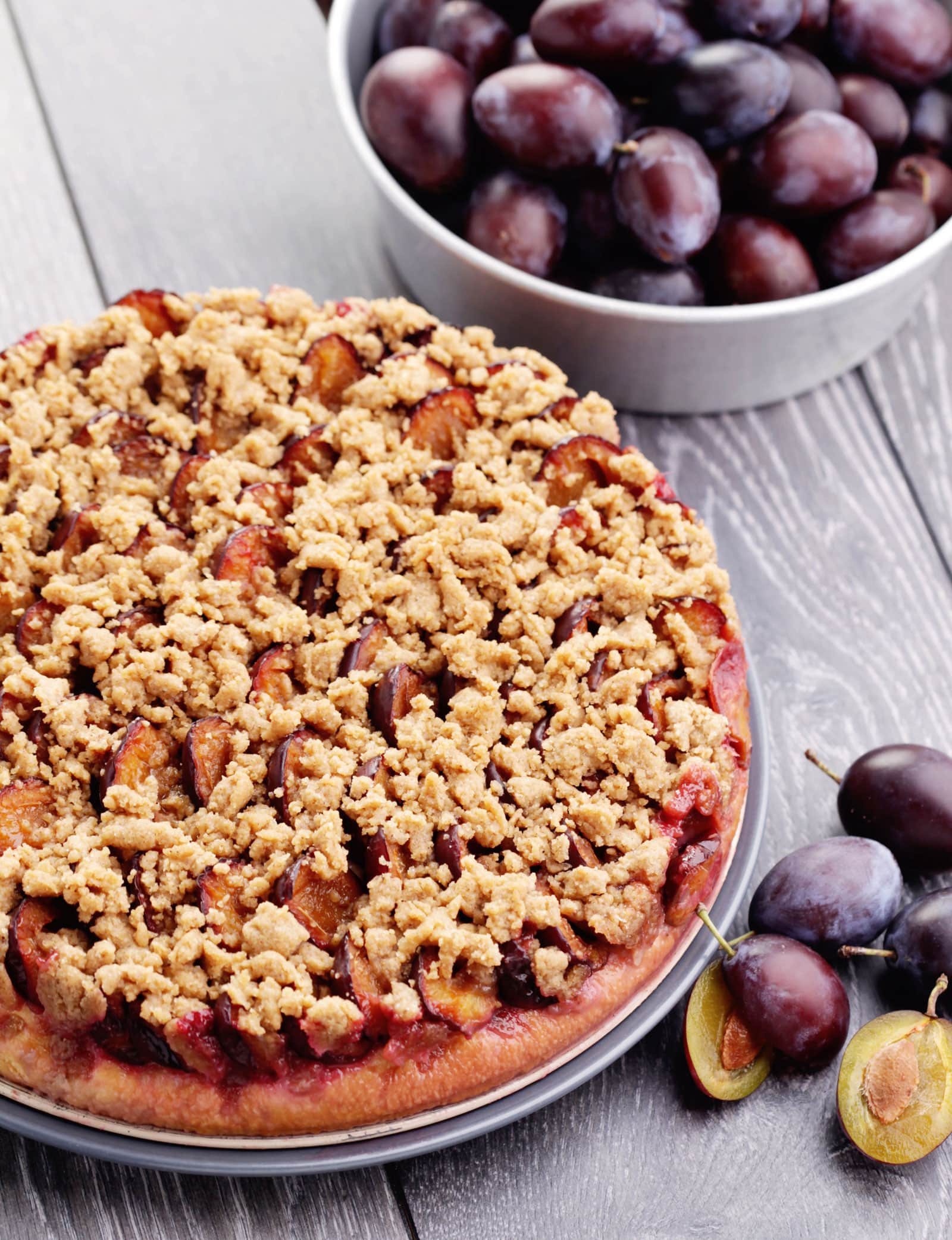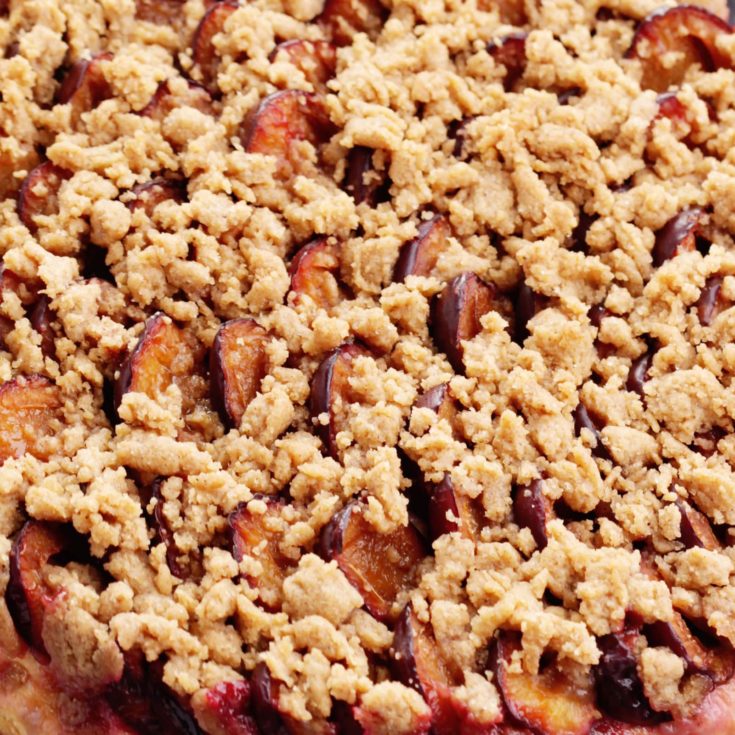Placek Drożdżowy ze Śliwkami i Kruszonką
Polish Plum Cake with Fresh Plums & Nutty Crumb Topping
How to pronounce it?
plat-sek zeh shlif-KA-me
‘Play’ to hear:

The aroma of a Polish-style Plum Cake (in Polish: ‘Placek ze Śliwkami’) coming from the kitchen is a sign of the upcoming fall.
In this delightful recipe, halved prune plums are nestled atop a fluffy yeast cake and sprinkled with a crunchy, buttery crumble. As the cake bakes, the batter rises – causing the plums to lazily sink into it. Fresh plums keep their shape, yet their flesh turns sweet and tender.
For the full list of ingredients & detailed instructions, please see the recipe card at the end of this post. But before you scroll, there’s important stuff to know below.
Traditional Polish cuisine is very seasonal and regional. After all, it had to be – to make the most out of the gifts of nature, available at a given time and place.
From mid-summer till the end of autumn, Polish orchards are abundant with plums. The branches are bending under the weight of the fruit.
One of the most popular ways to enjoy them is in cakes. These can be either based on yeast (like this one here), or a shortcrust pastry. The most famous enthusiast of plum cakes was Józef Piłsudski, one of the most important figures in Polish history. (source)
Do you need any special ingredients or equipment to make this Polish Plum Cake?
As long as you can purchase good plums, everything else should be easily available in any major supermarket.

🇵🇱 In Poland, we use a plum called “Węgierka” (which literally translates to “the Hungarian”). They’re egg-shaped and have thick purple skin. The flesh is yellow and firm.
🌍 Internationally, look out for ‘prune plums’, or ‘purple plums’. Damsons (Polish: “Śliwka Lubaszka”) will work as well. Make sure the fruits are quite firm – overripe, spongy plums will spoil your cake.
Equipment-wise, you’ll need:
- flour sifter
- digital scales; optional but extremely useful, especially in baking
- stand mixer; optional – but it makes the process easier
- large baking pan. Mine is sized at 35 x 40 cm (that’s just under 14’’ x 16’’) but that’s not a typical size in the US. A suitable alternative would be 12 x 18’’ (30 x 46 cm), two square 10’’ (26 cm) pans or two round 11’’ (28 cm) pans.
2 inches (5 cm) in height is enough.
What should you serve with this plum cake?
This Placek is a typical tea cake – or, as our US-based friends would call it – a coffee cake. It tastes best with a cup of hot beverage, such as tea or coffee.
When selecting wine, dry white (still or sparkling) pairs beautifully here.
Can you make this cake another way?
Yes. If you’re not a fan of yeast cakes, another popular version of this dessert is based on a shortcrust pastry. I hope to post a recipe soon.
You could also:
- Swap plums for apricots, peaches, nectarines or sour cherries.
- Sprinkle a generous handful of almond flakes on top.
- Sprinkle the cake with sugar or glaze with powdered sugar icing. I make a quick lemon icing by adding a few drops of lemon juice into powdered sugar and blending it together with a fork.
What diets is this plum cake suitable for?
This recipe is suitable for vegetarians.
How long can you keep this cake in the fridge?
As long as you’re planning to eat the entire cake on the same day (as it’s often the case), you can keep it at room temperature. Just cover it with a cloth and store it in a dark cool place.
Alternatively, cover the cake with cling film and refrigerate for up to 3 days.
Can I freeze this plum cake?
Yes, this recipe can be frozen. Before you do so, it’s worth portioning the cake into individual servings, so that you can retrieve them easily later on.
When the cake has cooled down, wrap each portion in cling film, or place it in a small freezer-friendly zip bag. Label it with a description and the date. Aim to consume within 3 months.
To thaw, leave it out at room temperature overnight.

Polish Plum Cake with Fresh Plums and Nutty Crumb Topping

Plums are a tasty reminder of late summer. While they’re great as a snack, folding them into simple fall cakes is an obvious choice. Try this Polish-style Plum Cake - it’s fruity, light and fluffy.
Ingredients
Cake
- 3.75 cups (17.6 oz, 500 g) cake flour, also known as extra fine sponge flour
- ⅔ cups (5 fl oz, 150 ml) milk
- 1 oz (28-30 g) fresh cake yeast; can replace with 0.5 oz (14-15 g) active dry yeast
- 7 tablespoons (3 oz, 85 g) sugar
- 1 stick (100-113 g) butter + some extra for greasing the pan
- 1 vanilla pod, can replace with 1 tablespoon of vanilla extract
- 4 egg yolks
- pinch of salt
- 2 pounds (0.9-1 kg) fresh plums
Crumb Topping
- 1 cup (120 g) all-purpose flour
- 3 oz (85 g) hazelnuts, ground; can be replaced with hazelnut or almond meal, or whole nuts ground in food processor
- 1 cup (3.5 oz, 100 g) powdered sugar, also known as icing or confectioner's sugar
- 1 stick (100-113 g) butter, chilled
Instructions
Using Fresh Yeast
- Prepare a large bowl. It can be the one that comes with your stand mixer - if you decide to use one. Sift in the flour.
- Heat up the milk until slightly warm (30 seconds in a microwave is usually enough).
- Create a “well” in the centre of the flour. Pour in the milk.
- Crumble the fresh yeast into a small bowl. Add one tablespoon of sugar to the yeast, blending together with a fork.
- Add the small bowl’s contents into the middle of the large bowl. Carefully blend it together in the middle of the bowl only - keeping the flour dry on the outer edges of the bowl.
- Cover the bowl with a kitchen towel and set it aside in a warm place. In 30-40 minutes it should double its size - if not, wait a little bit longer. Keep checking.
- As you wait, melt the butter (in a saucepan or in a microwave) and set it aside to cool down.
- After the leaven has risen, add in melted butter, the rest of the sugar (6 tablespoons), vanilla seeds (or vanilla extract), egg yolks and a pinch of salt. Knead together for a few minutes until the dough stops sticking to your hands. If using a stand mixer, go for a dough hook.
- Store the dough in a bowl and cover it with a kitchen towel. Set aside in a warm place and wait for it to double its size - in my case, it takes roughly 1-1,5 hours. In the meantime, you can prep the plums (see below).
Using Dry Active Yeast
- Melt the butter (in a saucepan or in a microwave) and set it aside to cool down.
- Prepare a large bowl. It can be the one that comes with your stand mixer - if you decide to use one. Sift in the flour and add in sugar, dry yeast and a pinch of salt. Stir to combine.
- Heat up the milk until slightly warm (30 seconds in a microwave is usually enough).
- Add the following ingredients to the flour: warm milk, melted butter, vanilla beans (or extract) and egg yolks. Knead together for a few minutes until the dough stops sticking to your hands. If using a stand mixer, go for a dough hook.
- Store the dough in a bowl and cover it with a kitchen towel. Set aside in a warm place and wait for it to double its size (for 1-1,5 hours, sometimes a bit longer). In the meantime, you can prep the plums and crumb topping (see below).
Prepping the plums
- Wash the plums thoroughly. Cut in halves and remove the pit.
- Grease the baking pan(s), you can sprinkle it lightly with flour as well.
- Move the dough onto your working surface and roll it out. Aim for a shape close to your baking pan. Once you’re done, move the dough over into a baking pan and prick it with a fork.
- Arrange the plum halves on top of the dough evenly, cut side up.
Prepping crumb topping
- In a medium-sized bowl, mix together: all-purpose flour, ground hazelnuts and powdered sugar.
- Cut chilled butter into cubes, add into the bowl. Rub the butter into the dry ingredients until it resembles breadcrumbs. Set aside until you’re ready to sprinkle over the cake.
Baking
- Scatter the crumb topping over the top of the cake.
- Cover with a kitchen cloth and set aside (for the final time) for 20-30 minutes. In the meantime, preheat the oven to 375°F (190°C) with fan-assist, or 390°F (200°C) without.
- Place the cake on the middle shelf of the oven. Bake for 25-30 minutes, then remove from the oven to cool down.
Nutrition Information:
Yield:
12Serving Size:
1Amount Per Serving: Calories: 437Total Fat: 14gSaturated Fat: 2gTrans Fat: 0gUnsaturated Fat: 11gCholesterol: 66mgSodium: 43mgCarbohydrates: 67gFiber: 4gSugar: 17gProtein: 11g
Sources:
Aleksandra Piłsudska, Józef Piłsudski’s second wife described her husband’s culinary preferences in her memoirs: “Wspomnienia” were published in 1940 in English as “Memoirs of Madame Piłsudski”. Available to read online here.
Polonist is reader-supported. When you buy through links on our site, we may earn a small affiliate commission. Learn more
Recipe Information
Filed under:
Alternative traditional/regional names:
Ciasto Drożdżowe ze Śliwkami, Drożdżówka ze Śliwkami
Also known / Misspelt internationally as:
Tested by:
First published on:
Recipe by / Adapted from:
Story by:
Bibliography / References: